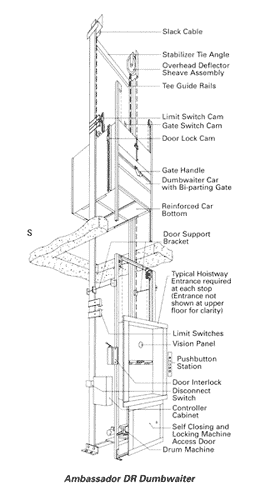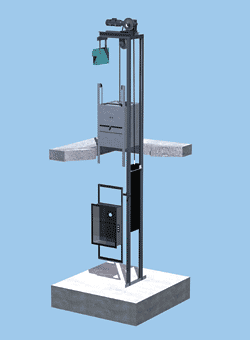Vertical Materials Handling Systems aka Dumbwaiters
The most valuable benefit of dumbwaiter systems is their seemingly never-ending usefulness in today's many building types. Found in restaurants, universities, clinics, hotels, hospitals, libraries, office buildings, warehouses, retail stores, clean room manufacturing, laboratories, airports, banks and courthouses, they can be configured for file distribution and trendy sportswear showrooms to prisons and four-star restaurants.
|
Sometimes they serve as a simple inexpensive substitute for an elevator. DiMarinisi & Wolfe Architects and Urban Designers designed a new state police station in Dartmouth, MA. The many boxes of documents and files were to be stored in the attic of the single story building. Options for transporting them included an elevator or a dumbwaiter. Since there was no need to transport people to the attic, partner Maury Wolfe, AIA, specified a dumbwaiter.
At other times they offer a simple solution to a design problem. For the expansion and renovation of the Dana Athletic Center, Bentley College, Waltham, MA, Jeffrey Millman Associates with Add Inc created a formal dining room on the second floor above the main dining space and kitchen. The problem was how to transfer the food from the kitchen to the satellite serving space above. The footprint was small and the existing elevator conveniently near the fitness area. So rather than relocate the elevator, reports project manager KyAnn Anderson of Add Inc, the team chose to send out a preconstruction bid for a dumbwaiter.
|
Other situations require new ways of solving old demands. During its fifteen years of working on eighty-plus court related projects, Moselely Architects of Richmond, VA, was frequently asked to install a pneumatic tube system (PTS). Used for delivering documents, a PTS requires an air compressor and 4-inches or greater tubing diameter bent in radiuses of approximately 48-inches. In recent years there have been fewer requests for a PTS, reports senior associate Ronald D. Crouch, AIA. With the greater use of computers and digital scanning, documents could be retrieved easily on screen. But when Moseley undertook the renovation and expansion of the Juvenile and Domestic Relations Court in Charlottesville, VA, the experienced clerk of the court asked for a document transfer system. Judging by the size of the sample documents, the 4-inch PTS tube was not large enough. Instead, the firm specified a dumbwaiter-for the first time, Crouch believes.











